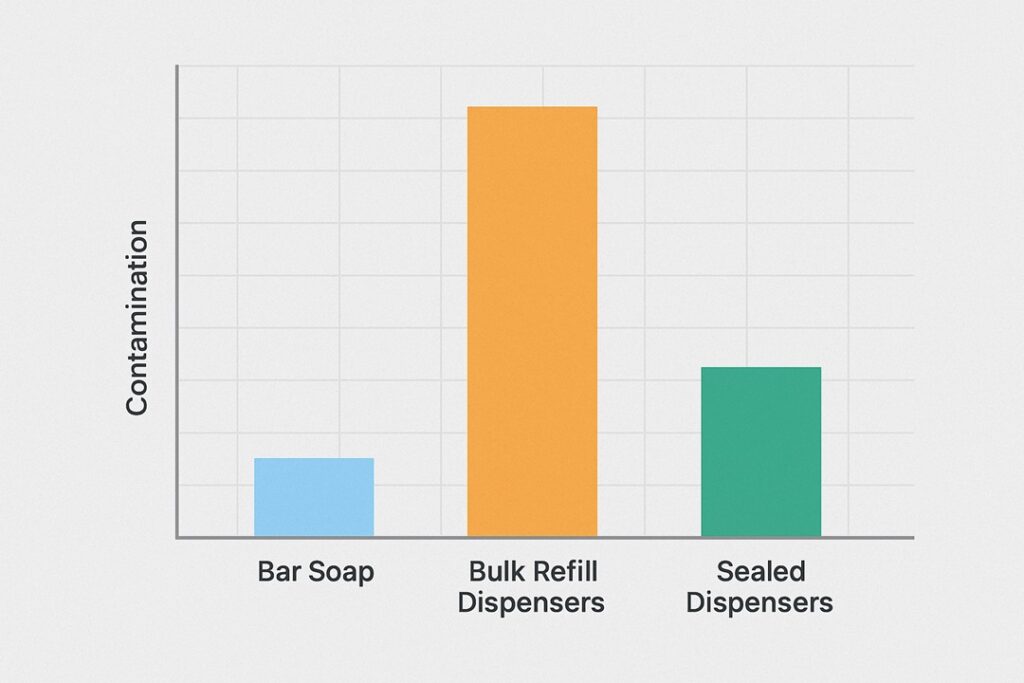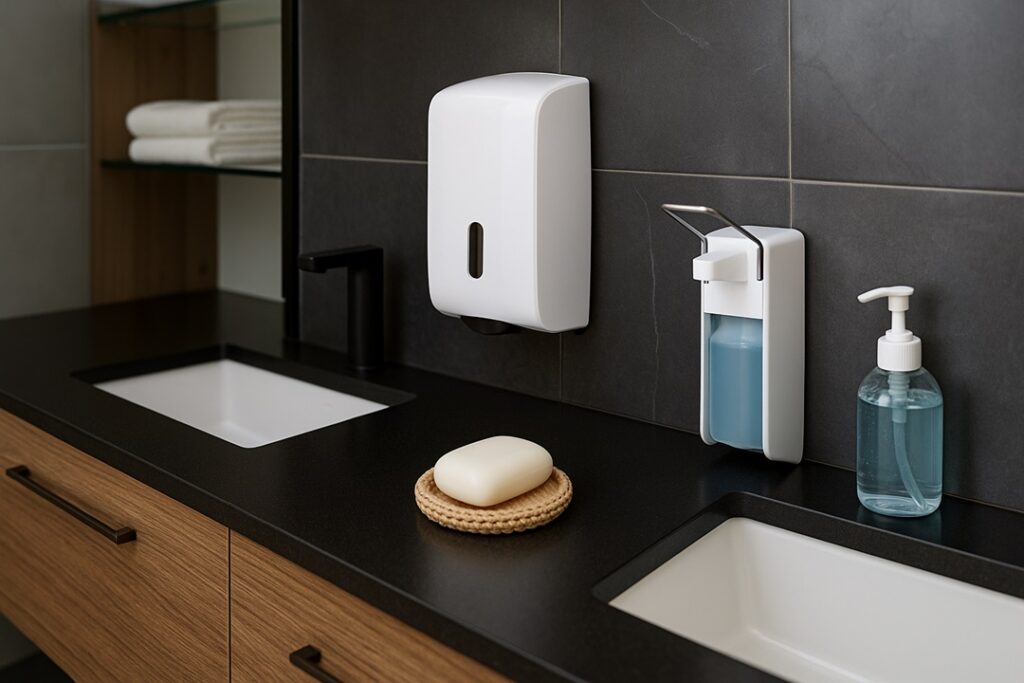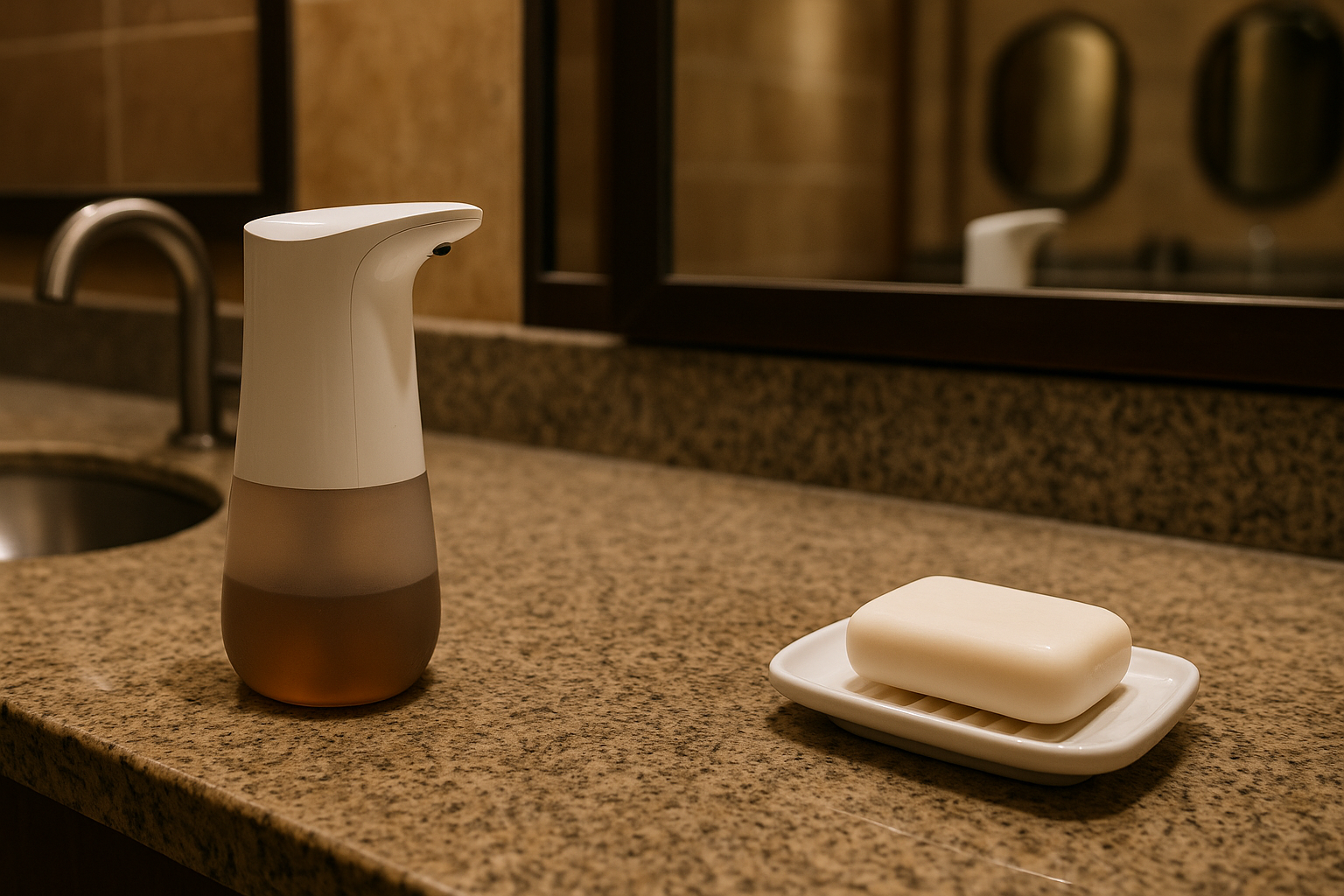The use of bar soap versus liquid soap dispensers has been argued over for decades. While bar soap tends to develop an unjustified reputation as a “germ carrier,” liquid soap in dispensers has been marketed as cleaner—particularly in public and healthcare environments. But what do scientific investigations actually indicate? This article summarizes research evidence, underscores practical issues, and cites both academic research and industry views (including BathSelect and FontanaShowers, two of the biggest suppliers of hygiene fixtures).
Getting to the Hygiene Question
Hand hygiene is perhaps the best method for preventing the transmission of infectious disease. Soap is important because it breaks down oils, dirt, and bacteria so that they can be washed away with water. The issue is not whether soap is effective—it is—but whether one type (bar or liquid in dispensers) is riskier to hygiene when used.
What Research Indicates Regarding Bar Soap
Timeless Experiments: No Germ Transfer
One of the most widely referenced studies, Heinze & Yackovich (1988) purposely contaminated bar soap with germs (E. coli and Pseudomonas aeruginosa). Volunteers used these bars to wash, and scientists detected no traceable bacteria transferred to their hands. This test strongly indicated that bar soap, though contaminated, doesn’t transfer germs from one user to another.
Why Bar Soap Seemingly Is Safe
The soap bar’s outer layer is dissolved and washed away when used. Surface bacteria are washed away with water and lather, providing very little opportunity for transfer. Research appearing in JAMA Network also confirms that bar soap is clean when used under running water.
Home Best Practices
- Place soap on a self-draining dish so that it has time to dry between uses.
- Replace bars when they become too soft or broken.
- Use personal bars if family members have skin infections.
What Research Suggests Regarding Soap Dispensers
Bulk-Refill Dispenser Contamination
A seminal study by Zapka et al. (2011) examined bulk refillable dispensers—those in which liquid soap is filled from a large container. Scientists discovered that approximately 1 in 4 bulk dispensers were contaminated with bacteria. Worse yet: handwashing using this contaminated soap increased bacterial numbers on hands.
How Contamination Occurs
- “Top-off” refilling (putting new soap on top of existing) weakens preservatives and adds microbes.
- Reservoirs and pumps are now moist settings where bacteria create biofilms.
- After they have been contaminated, dispensers will contaminate every hand that is washed with them.
Sealed-Cartridge Systems: The Safer Choice
Sealed cartridge dispensers of today eliminate this risk since each refill is factory-sealed with a nozzle of its own. This construction avoids external contamination and safeguards product integrity. Industry publications like CleanLink and CMM Online vehemently suggest sealed systems in public or clinical environments.
Health Authority Guidelines
The World Health Organization (WHO) accepts alcohol-based hand rub (ABHR) in healthcare except where hands are visibly soiled. If soap is to be used, sealed dispensers are recommended.
The Centers for Disease Control and Prevention (CDC) also second this, citing sealed liquid dispensers and proper servicing as essential to infection control.
Healthcare Facilities: Frequently avoid bar soap for operational uniformity—not due to demonstrated risk, but to maintain control in high-frequency use settings.
Hygiene Showdown: Bar Soap vs. Soap Dispensers

Bar Soap (Low-Traffic Household Areas)
- Evidence: No evidence of demonstrated transfer of bacteria upon washing.
- Optimum Use: Good for household hygiene when properly dried out.
- Low cost and environmentally friendly due to reduced plastic packaging.
Sealed Soap Dispensers (Public & Hospital Environments)
- Evidence: Maintain product sterility; prevent contamination.
- Optimum Use: Essential in high-traffic environments (hospitals, schools, airports).
- Advantages: Cleaner than bulk refill systems; allow touchless sensor integration.
Bulk Refillable Dispensers (Public Spaces)
- Evidence: Extremely prone to contamination; will enhance bacterial load.
- Recommendation: Replace with sealed units or maintain strict cleansing procedures.
Industry Perspectives: BathSelect and FontanaShowers
While academic studies highlight risks and advantages, industrial vendors offer pragmatic solutions.
BathSelect
BathSelect provides a wide range of touchless and commercial-grade soap dispensers. Its emphasis on sealed systems aligns with hygiene research in eliminating contaminants. Its products are being marketed to hospitals and hotels where hygiene has to be non-negotiable.
FontanaShowers
FontanaShowers makes a specialty of sensor-controlled soap dispensers and faucets. Its touchless technology counters hygiene concerns by eliminating the need to touch pump handles, further minimizing contamination potential in high-use areas.
Both companies show how modern dispenser design brings learned discoveries into practical, sanitary solutions for commercial bathrooms.
Myths and Misconceptions
“Bar soap is dirty and unsafe.”
Not true. Research indicates it does not pass on germs from one user to another.
“Any liquid dispenser is safer.”
False. Bulk-refill dispensers tend to disperse bacteria rather than eliminate them.
“Antibacterial soap is a must.”
Not so. Proper technique and sealed dispensing units are more important than antibacterial additives, according to the CDC.
Practical Recommendations

- At Home: Bar soap is hygienic and green. Use a draining dish and allow bars to dry.
- In Public/Shared Spaces: Utilize sealed liquid dispensers—ideally sensor-operated models from suppliers such as BathSelect or FontanaShowers.
- In Healthcare: Adhere to CDC/WHO protocols. Use ABHR wherever feasible, and keep any soap dispensers sealed-cartridge units.
- Never “Top Off” Bulk Soap Dispensers: Empty and sanitize totally before refilling—or alternatively, replace with sealed systems.
Conclusion
When hygiene is at stake:
- Bar soap is okay at home and not the “germ brick” it is often presumed to be.
- Liquid soap in sealed dispensers is ideal in public or clinical environments, particularly when used with sensor/touchless technology.
- Bulk refillable dispensers are the actual weak link, as they tend to get bacteria growing and add to contamination.
Science, recommendations, and industry innovations all concur: select the appropriate soap form for the appropriate context. Either through traditional bar soap in your home or sealed, touch-free dispensers in public toilets like those from BathSelect and FontanaShowers, good hand hygiene is still the foundation of stopping infection.

No responses yet